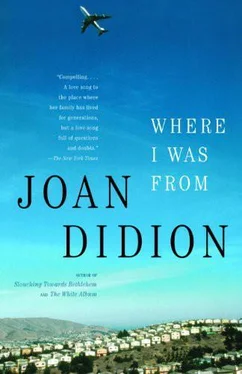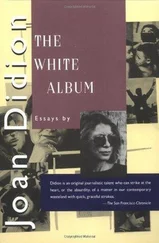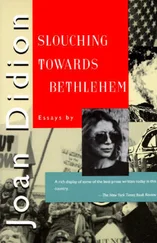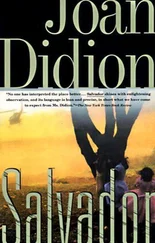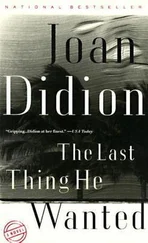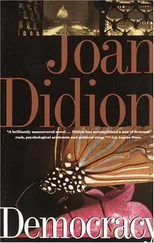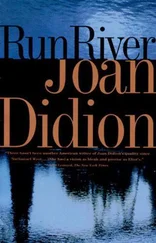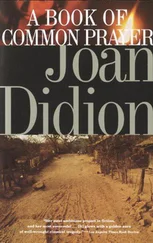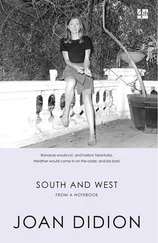The year Martha dies is 1949. By 1959, as presented in Run River , this “true” California has been largely obliterated. The pear orchards on which Lily herself grew up are being relentlessly uprooted: her mother is selling off the acreage for development as fast as the bank will allow her to subordinate it. The ranches immediately upriver and downriver from the McClellan ranch are already subdivisions, Rancho Del Rio No. 1 and Rancho Del Rio No. 3. This is unsettling to Everett but not so to his and Lily’s son, Knight. “They’re just biding their time,” Knight says. “Waiting it out for Rancho Del Rio No. 2.” Knight is about to go east to college, to Princeton, a “new” kind of choice (the “traditional” choice would have been Berkeley or Stanford) and so, again, unsettling. Knight is full of himself, and lectures his mother, who has asked him, since he is driving to Berkeley, to pick up some new paperback books on Telegraph Avenue. From Knight’s point of view:
She did not seem to realize that there were now paperback bookstores in Sacramento. She and his father would never seem to get it through their heads that things were changing in Sacramento, that Aerojet General and Douglas Aircraft and even the State College were bringing in a whole new class of people, people who had lived back East, people who read things. She and his father were going to be pretty surprised if and when they ever woke up to the fact that nobody in Sacramento any more had even heard of the McClellans. Or the Knights. Not that he thought they ever would wake up. They’d just go right along dedicating their grubby goddamn camellia trees in Capitol Park to the memory of their grubby goddamn pioneers.
There are other signs of change, which, in the construct of the novel, is understood to mean decline. There is Everett’s older sister, Sarah, who lives outside Philadelphia, another “new” kind of choice, with her third husband: again, a new kind of choice. Sarah has stopped by the ranch on her way to Maui (still another new choice, since the traditional Hawaiian destination would be Honolulu, on the Lurline) , apologized to her husband for the Valley heat (“true” children of the Valley are made uneasy by summer temperatures that do not reach three digits), and made it clear to Everett that she tolerates his wish to keep as ranches rather than subdivide their joint inheritance, seven thousand acres on the Sacramento and Cosumnes Rivers, only as a provisional indulgence. “Surely we’ve had offers,” Sarah suggests to Everett. Everett allows that interest has been expressed in the ranch on the Cosumnes. “I don’t care so much about the Cosumnes,” Sarah says. “The Cosumnes at least brings in a little cash.”
There is also the man Everett will eventually shoot, Ryder Channing. Ryder Channing is the only character in the novel not “from” California, in other words one of the “new people.” He first meets Martha in 1944, when he is stationed at Mather Field in Sacramento, and his appearances on the ranch to see her, which continue, inexplicably to Everett, after the war has ended and this person not from California should have gone home to wherever he came from, are presented as troubling elements. He has no intention of leaving, he tells Everett, because California is where the future is being made:
Starting now. Channing had the hunch they were in on the ground floor of the biggest boom this country had ever seen. Talk about your gold rush. And he wasn’t the only one who believed in Northern California. Just one example, the Keller Brothers believed in Northern California to the tune of five million berries.
“The Keller Brothers,” Everett said. “I don’t believe I know them.”
The Keller Brothers, Channing explained patiently, were developers. Los Angeles developers who believed in Northern California, in the Valley specifically, to the tune of five million smackeroos. Which they were putting into the Natomas District.
“I never heard of any Kellers in the Natomas,” Everett said.
With what appeared to be infinite restraint, Channing inspected and crumpled three empty cigarette packages before answering. “They aren’t in the Natomas right now. They want to develop the Natomas.”
“Who’s putting up the money? How can they raise five million dollars on land they haven’t got?”
“Those sweethearts could raise five million dollars with a plot plan on the back of a goddamn napkin. Anyway,” Channing added, apparently abandoning his effort to justify the Kellers’ ways to Everett, “that’s just one example. The point is we’re sitting right here on the ground floor with the button pushed go.”
Ryder, who because he has no California heritage is incapable of betraying it, not only sees the future but seizes it: he abandons Martha in 1948 to marry the daughter of a recently rich developer. (“Construction money, Everett believed. Wartime. It was all mixed up in his mind with Henry Kaiser.”) Martha, about whom there have been previous suggestions of histrionic instability (at parties the year she was sixteen “it had been impossible not to notice her, as it might have been impossible not to notice someone running a high fever, or wearing a cellophane dress”), spends the winter between Ryder’s marriage and her own death trying in vain to embrace this New California from which Ryder had come and to which she has now lost him: “She went everywhere, met everyone. She met builders, promoters, people looking for factory sites and talking about a deep-water channel and lobbying for federal dams; people neither Everett nor Lily would have known existed had she not told them. She went to large parties at new country clubs, went to small parties at new apartment houses, and went, almost every afternoon, to inspect subdivisions opened by one or another of the boys she knew who were going into the real estate business.”
This is a not inaccurate characterization of the way Sacramento, or for that matter California itself, felt to a child growing up during the postwar boom years, the late 1940s and early 1950s; sometimes, say when I hear about what the Alameda Corridor will bring us, I still catch the echo of those years. It was true that it was suddenly possible, as if overnight, to buy paperback books at Levinson’s bookstore downtown. It was true that it was suddenly possible, as if overnight, to see foreign movies— Open City, The Bicycle Thief , a lachrymose Swedish young-love picture called One Summer of Happiness —at the Guild Theater in Oak Park, although the only member of my family to regularly see them was a half-deaf great-aunt for whom subtitles offered the novel possibility of actually following the action onscreen. It was true that the habits and customs of “old Sacramento” (the school-vacation jobs on the ranches and at the canneries, the swimming in the rivers and wading in the ditches, the dutiful study of the agricultural exhibits at the California State Fair) were giving way to a more urban, or suburban, life, in which children swam in clear water in backyard pools lined with gunite and bought Italian typewriters and ate pears bought in supermarkets rather than dropped off in lugs by the relatives who grew them.
All this was true, and yet there was in Run River something that was not true, a warp, a persistent suggestion that these changes brought about by World War Two had in some way been resisted by “true” Californians. Had not any such resistance been confined to the retrospect? Were not “changes” and “boom years” what the California experience had been about since the first American settlement? Were we not still willing to traffic our own history to get what the railroad could bring us?
Take for example this business of laying the iconic camellias in Marthas grave: in point of fact the whole notion of planting camellias for the pioneers — there was in the park across from the state capitol building in Sacramento a “Camellia Grove” set aside for this purpose — had originated with my father’s stepmother, Genevieve Didion, who was for many years the president of the Sacramento City Board of Education and was said by the rest of the family, not entirely approvingly, to be “political.” All association of camellias with pioneers, in other words, derived from the same spirit of civic boosterism that would later turn Front Street, along the river, into the entirely ersatz “redevelopment” known as “Old Sacramento,” twenty-eight riverfront acres of shops selling trinkets and souvenirs and popcorn. “The pioneers,” in other words, had become a promotional tool, Sacramento’s own unique selling proposition, a way of attracting tourists, conventions, a new kind of cash that did not depend on crops: one more version of the weakness for the speculative venture that Charles Nordhoff had noted in 1874.
Читать дальше
Конец ознакомительного отрывка
Купить книгу
